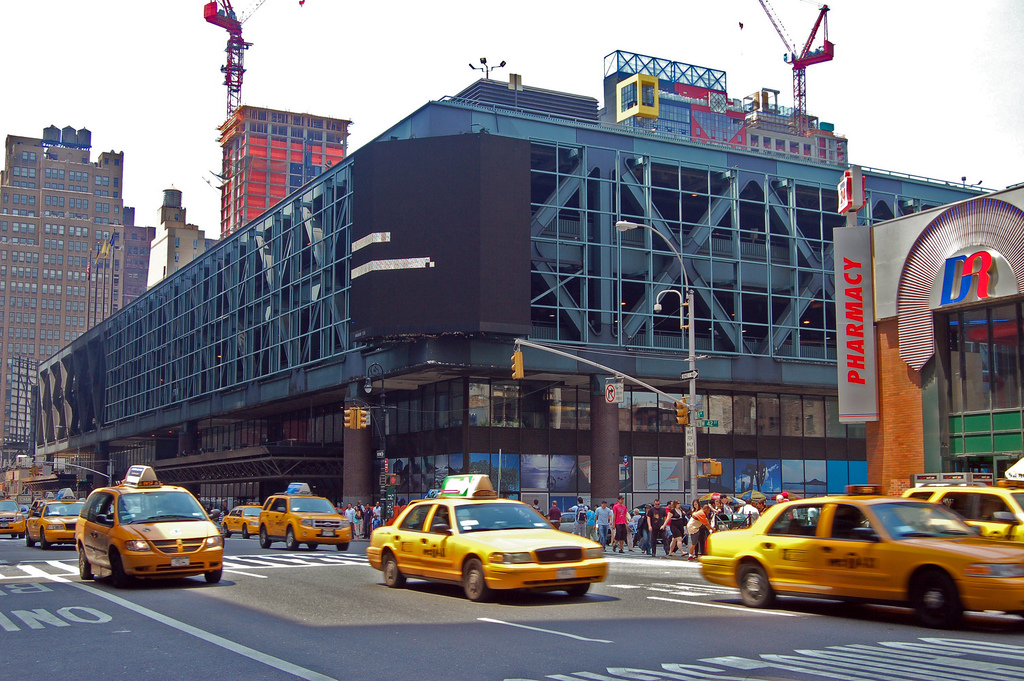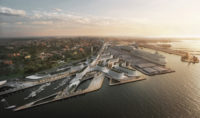Architects often find competitions — which require large amounts of work for little or no pay – exploitative. In fact, in a survey conducted last year by RECORD and the Van Alen Institute, nearly 80 percent of respondents cited lack of compensation as a problem. The Port Authority of New York and New Jersey did little to improve that situation when, on March 11, it announced a competition to replace Manhattan’s 65-year old Port Authority Bus Terminal.
Designers were asked to come up with plans for a sprawling transportation complex, satisfying a mind-numbing list of logistical and legal, financial and functional requirements, practically overnight. The Port Authority would retain the copyright in everything submitted, which it could use in any way it wanted, without paying competitors a cent.
Even the finalists (likely to do thousands of hours of work in stage two of the competition) would not receive a penny for their efforts. The eventual winner would get a a $1 million honorarium, but, alarmingly, no guarantee of employment if and when the project went ahead.
But a targeted effort by the New York City, New York State, and New Jersey chapters of the AIA resulted in a number of changes that make the competition, if not ideal, significantly better. The organizations, in an effort led by AIA New York [City] executive director Benjamin Prosky, wrote to the Port Authority suggesting a number of changes in the competition brief, all of them consistent with the AIA’s 2011 Handbook of Architectural Design Competitions.
To its credit, the Port Authority responded to the letter quickly, and announced changes to the competition in less than a week, vindicating Prosky’s decision not to take his concerns to the press.
“Our goal was to achieve real change for architects, not just blast a public agency,” says Prosky. “So we quietly engaged the PA and I think real improvements have been made.”
Under the old rules, the competition seemed “set up to fail,” Veronica Vanterpool, executive director of the Tri-State Transportation Campaign, told NorthJersey.com. And according to Prosky, the AIA “had heard from several significant firms that due to the terms of the brief they would not enter.”
Changing that was particularly important, he says, given the importance of the project to the region. “Our goal was not only improve conditions for architects, but to give architects a chance to deliver better designs for the public good,” he says.
Among the changes: the deadline for first stage entries was been pushed back from April 12 to April 28. The Port Authority also relinquished most claims to the first round entries—it can publicize the plans, but not otherwise employ them. Most significantly, the winners of stage one – approximately five teams chosen to advance to stage two –will receive honorariums of $200,000 (a generous sum, but not a windfall for firms that will be assembling large teams of consultants).
Almost everyone agrees the aging bus terminal needs to be upgraded or replaced. But the 12 Port Authority commissioners, who are appointed by the governors of New York and New Jersey, have been struggling to come up with a plan.
One seemingly sensible idea was to build a terminal in New Jersey, where passengers could switch from buses to trains -- shortening travel time and easing congestion in the Lincoln Tunnel. That idea is now off the table. Meanwhile, the Authority commissioned the giant engineering firm Parsons Brinckerhoff and the architecture firm Kohn Pedersen Fox to come with alternative plans for a number of sites that it owns along the west side of Manhattan. The firms presented 15 different concepts, many including large office towers that would help defray the costs of the development. The commissioners narrowed the 15 down to five—each expected to cost at least $10 billion and take a more than a decade to complete. But unable to settle on one plan, they decided in October to create a competition.
Commissioner David Steiner, a New Jersey real estate developer, said that with the competition, perhaps “some genius will come along” with an idea that hasn’t been proposed yet.
But the competition, as organized by the the Port Authority, is unlikely to appeal to the lone genius. It requires competitors to “demonstrate a record of expertise and accomplishment in the design and planning of large scale, intermodal mass transportation projects within high-density urban environments.” Entries are expected to address a long list of requirements that go far beyond design, such as: “Encourages attraction of private capital as an element of project ‘deliverability,’ including leveraging the Port Authority’s real estate development rights.” In addition, competitors are instructed to “to suggest alternative sites for a new Bus Terminal should their analysis determine that the proposed site west of Ninth Avenue is not optimal.” Only the largest firms can hope to jump those hurdles.
Perhaps the Authority should have announced an ideas competition, which sole practitioners and even students could have entered. Then it could have issued a request for qualifications, to attract some of the few firms capable of bringing such a massive project to fruition. But under the current plan, if you have a great idea, but don’t work for a mega-firm, the Port Authority, and the public, will probably never know it.






Post a comment to this article
Report Abusive Comment